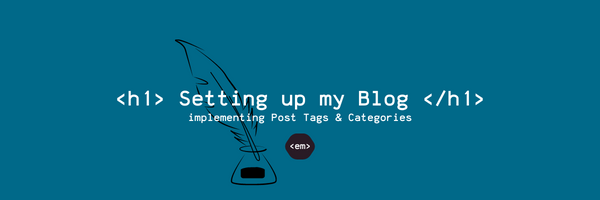
Organising my Jekyll Blog with Categories
Post tags and categories make it easier to navigate through your blog and find relevant posts! In this post I'm explaining how to structure Jekyll blog posts using post categories.I recently set up this blog using Jekyll, GithubPages and Minima (if you want to learn more about why and how, check out the first parts of this series here!). Once I had a couple of posts on my blog, I realised I wanted to organise my posts better - into different series and technology groups. I wanted to make it as easy as possible for someone reading my post about customising the minima Jekyll template to find other posts about working with Jekyll, or using HTML/CSS to customise web frontend.
After doing some research, I discovered two ways of doing this:
- Tags: Jekyll Tags are one or more attributes set for a given post. Tags can be added to Jekyll posts using the frontmatter keys
tagortags. - Categories: Jekyll Categories are similar to tags and can be set in frontmatter using keys
categoryorcategories. Other than tags however they work “more hierarchical” - if a post is in a directory other than_posts, every directory will be treated as another post category.
This is part (2) of two posts, focusing on organising blog posts using categories. Check out the part (1) if you want to learn more about tags!
What are Post Categories?
Jekyll Categories are a way of structuring blog posts in a hierarchical way. Blog posts within one category are grouped together and relevant for one main project or goal.
On my blog for example, I am writing about different projects - this series about setting up my blog with Jekyll, Minima & Co is one of them. I want each project to have its own little overview page and description, and I want blog posts to be accessible through their category.
Implementation
To implement categories on my blog posts, and add overview pages for each category, I need to implement the following things:
- adding categories to the post itself and showing them on the post page
- adding the overview page per category that shows general information about the given category
I’m additionally going to use Jekyll Collections to store information such as a category description for each category.
Setting up Category Collections
As said, I’m using Jekyll Collections to store general information about each post category. I’ll call the categories I’m focusing on in this example “project” categories, you can change that name to anything you like.
First, I need to tell Jekyll that there’s a collection called “projects” in this blog. Collections can be configured in _config.yml like so:
collections:
projects:
output: true
permalink: /:collection/:categories:output_ext
This also tells Jekyll that the link to the category overview page is <my_blog_url>/<collection_name>/<category_name>.html - in my case, if I have a project called “blog_project”, the URL is going to be <my_blog_url>/projects/blog_project.html.
To set up the “blog_project” category, I need to create a new directory in my blog root called _projects. In this directory, I’m creating a file called blog_project.markdown which sets up the blog_project category.
---
title: "Blog Project"
categories: blog_project
layout: project
---
In this series I'm writing about setting up this block with the help of GitHub Pages, Jekyll, Minima & Co.
The project layout is defined in the next step.
Category Overview Page
Now that I have created a new category, I need to tell Jekyll how to render project category overview pages. In the _layouts directory, I’m creating a new file called project.html which defines the structure of every project overview page.
This is what my project.html looks like:
---
layout: page
---
{{ content }}
<h2>{{ page.list_title | default: "Posts" }}</h2>
<div>
<ul>
{% assign page_category = page.categories | first %}
{% for post in site.posts %}
{% if post.categories contains page_category %}
<li>
{%- assign date_format = site.minima.date_format | default: "%b %-d, %Y" -%}
<b>
<a href="{{ post.url | relative_url }}">
{{ post.title | escape }}
</a>
</b> - <i>{{ post.date | date: date_format }}</i>
</li>
{% endif %}
{% endfor %}
</ul>
</div>
This code snippet does the following:
- It first prints the
contentof the project category - eg the description forblog_projectI implemented in the first step - It then iterates through all posts of that category, and prints the post title that links to the respective blog post
Adding Category to Posts
The last step is now to actually add blog posts for the new blog category. There are two ways of doing this:
- Jekyll Frontmatter: one can add categories to posts using the
categoryfrontmatter keys on a post itself, like this
---
layout: post
title: "Hello World!"
category: blog_project
---
Hello World!
This post has a Category :-)
- Post Directory: Alternatively, one can structure the raw post files in separate directories, which automatically adds respective categories to each post. In my case, my directory structure looks like below - the
hello_world.markdownpost will automatically be in theblog_projectcategory.|─ my_blog/ ├─ _includes/ ├─ _layouts/ ├─ _posts/ ├─ _projects/ | └─ blog_project.markdown ├─ projects/ | └─ blog_project/ | └─ _posts/ | └─ hello_world.markdown └─ _config.yml
Here’s what the final blog_project overview page looks like

Here’s the overview page for the blog_project category
Conclusion
Categories are really helpful for bringing more structure into blog posts and grouping posts based on projects and overarching topics.
Check out the first part on this topic that’s using tags for connecting blog posts by topic!
How are you organising your Jekyll blog? Are you using tags? Categories? Something else? Let me know in the comments :-)